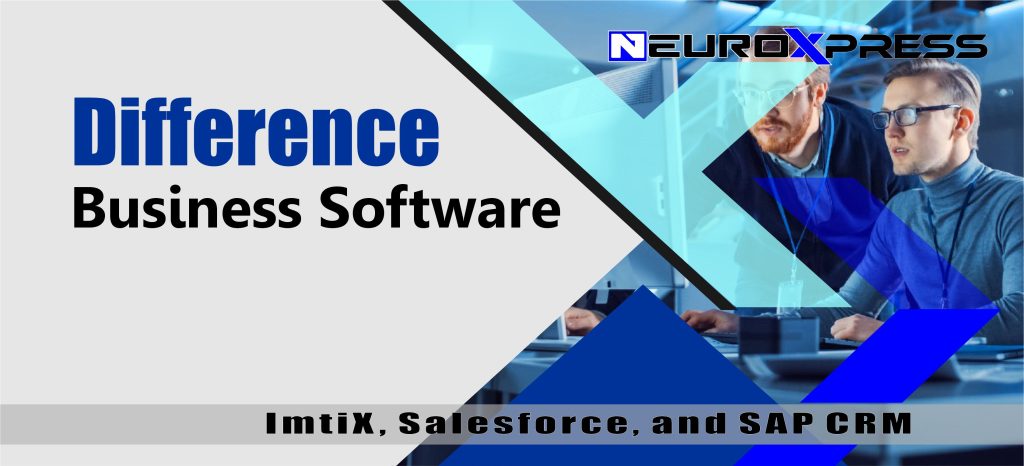
Introduction
Choosing the right Customer Relationship Management (CRM) platform can define the trajectory of your sales, marketing, and service success. Among the major players in the CRM space, Ima̍tix, Salesforce, and SAP CRM each offer distinctive approaches tailored to different business needs. But what truly sets them apart?
In this comprehensive guide by NeuroXpress, we’ll walk you through the core differences between these platforms, diving into use cases, core functionalities, pros and cons, and which type of organization is best suited for each.
Storytelling: One CEO, Three Demos
When Michelle, the CEO of a mid-sized logistics firm, decided to upgrade their CRM platform, she shortlisted Ima̍tix, Salesforce, and SAP. Each vendor pitched with confidence, but their approaches varied widely. Salesforce dazzled her with its cloud-first agility, SAP promised deep enterprise integration, and Ima̍tix offered a niche, high-performance middleware-centric strategy.
Michelle’s story is all too common—a business leader trying to match tech stack with real-world needs. Let’s break down what each system offers and how they differ.
Quick Overview Table: Ima̍tix vs Salesforce vs SAP CRM
| Feature/Capability | Ima̍tix | Salesforce | SAP CRM |
|---|---|---|---|
| Core Focus | Messaging, middleware, and automation | Cloud-based CRM with wide app ecosystem | Enterprise-grade CRM & ERP integration |
| Deployment | On-prem & hybrid | Cloud-native | On-prem, hybrid, and cloud |
| Ideal For | Dev teams, finance, telco, healthcare | SMEs to enterprises across all industries | Large enterprises & multinational orgs |
| Integration Style | Middleware-first (Xitami, ZeroMQ roots) | API-driven (AppExchange) | Deep SAP ecosystem integration |
| Customization | High (developer-centric) | Very high (via Apex, Flow, APIs) | Moderate to High |
| AI & Analytics | Minimal native AI | Built-in Einstein AI | SAP HANA powered BI |
| Cost Level | Low to moderate | Moderate to high | High |
1. Ima̍tix: Developer-First, Middleware-Oriented
Overview
Ima̍tix is less known in the mainstream CRM world but has carved a niche in high-performance computing, messaging, and middleware services. It’s the original creator of technologies like Xitami web server and ZeroMQ messaging protocol.
Best For
- Organizations requiring fast, customized backend integration
- Businesses in finance, telco, or IoT-heavy environments
- Teams that prioritize performance over flashy UI
Pros
- ✅ Lightweight and efficient
- ✅ Excellent for system integrators
- ✅ Low-cost entry
Cons
- ❌ Lacks full-featured CRM interface
- ❌ Minimal support for sales or marketing automation
- ❌ Requires strong dev expertise
2. Salesforce: The Ecosystem Giant
Overview
Salesforce dominates the CRM world for a reason: its cloud-first approach, massive app marketplace (AppExchange), and robust automation tools make it incredibly versatile.
Best For
- Startups, SMEs, and enterprises needing scalability
- Sales-heavy organizations and service providers
- Teams embracing low-code tools and automation
Pros
- ✅ Powerful automation and AI (Einstein)
- ✅ Highly customizable with strong developer tools
- ✅ Large support and partner ecosystem
Cons
- ❌ Can get expensive quickly
- ❌ Steep learning curve for admins
- ❌ Occasional performance slowdowns
3. SAP CRM: Enterprise-Level Process Management
Overview
SAP CRM is often chosen by companies already invested in SAP’s ERP systems. It delivers robust B2B capabilities, especially in manufacturing, supply chain, and logistics.
Best For
- Large organizations with existing SAP architecture
- Companies needing global supply chain CRM integration
- Enterprises with complex approval and workflow needs
Pros
- ✅ Native integration with SAP ERP & S/4HANA
- ✅ Strong B2B features
- ✅ Proven track record in enterprise environments
Cons
- ❌ Complex setup and onboarding
- ❌ Limited user interface compared to newer CRMs
- ❌ Higher total cost of ownership
Storytelling: Post-Deployment Reflections
Six months after going live, Michelle reflects on the CRM selection. Salesforce brought speed and real-time dashboards for her sales team. SAP was chosen by a competitor in the industry for its tight manufacturing integration. Meanwhile, a fintech startup her friend runs chose Ima̍tix to build a CRM layer entirely from scratch, focusing on event-driven architecture.
Her choice? Salesforce—because her team needed agility, not more complexity.
Comparison Summary Table: Use Case Mapping
| Use Case | Ima̍tix | Salesforce | SAP CRM |
|---|---|---|---|
| Dev-Centric Custom Workflows | ✅ | ✅ (via Apex/API) | ⚠️ (more rigid) |
| Sales Automation | ❌ | ✅ | ✅ |
| Deep ERP Integration | ⚠️ | ✅ (via connectors) | ✅ Native |
| Middleware Integration | ✅ | ⚠️ | ✅ |
| Fast Time-to-Value | ⚠️ | ✅ | ❌ |
| Global B2B Rollouts | ⚠️ | ✅ | ✅ |
Conclusion: Which One Should You Choose?
Each platform serves a different vision of CRM:
- Choose Ima̍tix if you’re deeply technical and want lightweight messaging middleware to support custom CRM layers.
- Choose Salesforce if you’re seeking a scalable, cloud-native CRM with robust automation and a vast ecosystem.
- Choose SAP CRM if you’re operating a large-scale enterprise and need native ERP-CRM integration across borders.
Every organization has a unique path. The key is to align your CRM selection with the real-world pain points and future growth of your team.
External Resource
- Learn more about Salesforce CRM at Salesforce.com
- Explore SAP CRM at SAP.com
- Discover Ima̍tix projects and documentation at imatix.com
Stay informed with CRM trends and reviews from NeuroXpress, or dive deeper into our curated CRM Software Reviews.